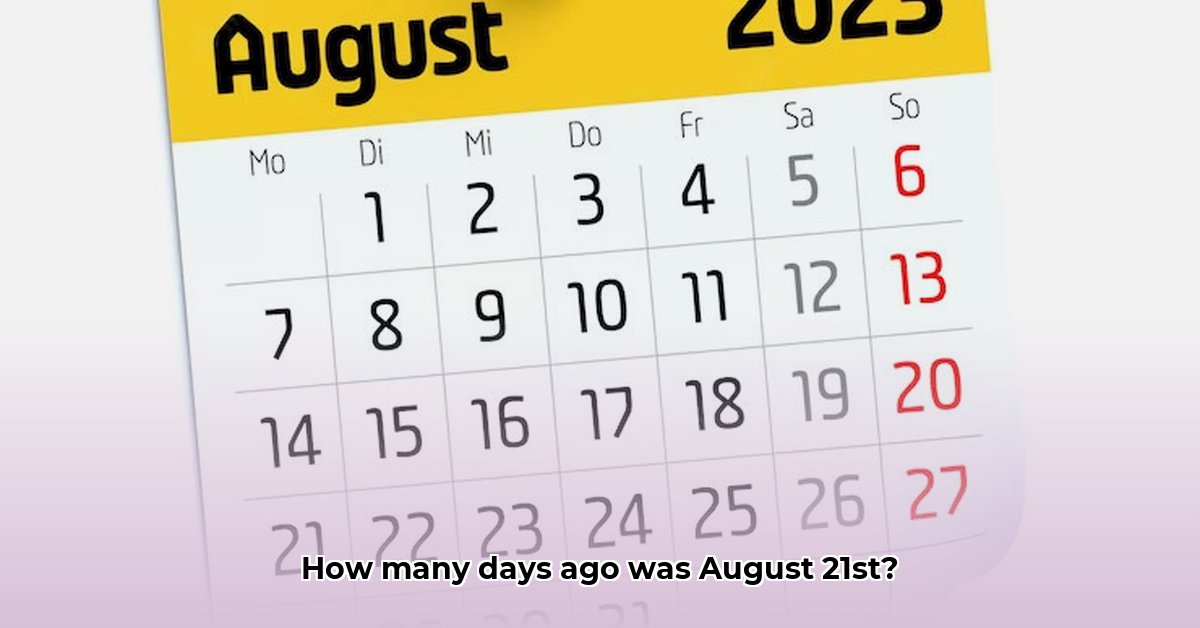
As of February 23rd, 2025, August 21st, 2023, was 579 days ago. However, calculating the precise number of days between two dates isn't as simple as subtracting; the Gregorian calendar's complexities—leap years and varying month lengths—demand a more nuanced approach. This article will guide you through accurate date calculations, examining the intricacies of our calendar system and its real-world implications.
Basic Calculation: A First Approximation
A naive approach might be to simply subtract the dates: February 23rd, 2025, minus August 21st, 2023. While this provides a rough estimate, it neglects crucial calendar nuances. Online calculators offer a more streamlined solution, but understanding the underlying principles is essential. Let's examine a manual calculation for illustrative purposes, though it may not yield perfect precision.
Step-by-Step Manual Calculation (Illustrative)
- Days remaining in August 2023: 31 (days in August) - 21 = 10 days.
- Days in subsequent months of 2023: 30 (September) + 31 (October) + 30 (November) + 31 (December) = 122 days.
- Days in 2024: 366 days (2024 is a leap year).
- Days in 2025 to February 23rd: 23 days.
- Total: 10 + 122 + 366 + 23 = 521 days.
Note: This manual calculation is an approximation. A perfectly accurate calculation requires accounting for leap years in greater detail and potentially specialized software.
The Gregorian Calendar: A Closer Look
Our Gregorian calendar, while a seemingly straightforward system, is far from perfectly regular. Leap years, introduced to compensate for the Earth's slightly irregular orbit, add an extra day every four years (with specific exceptions for century years). Combined with the varying number of days in each month, this irregularity complicates simple subtractions. This is why even the simplest online calculators often return slightly different results—they're designed to handle these nuances.
Have you ever wondered why February has a variable number of days? It stems from the calendar's attempt to synchronise with the solar year, highlighting the inherent imperfections in aligning a purely numerical system with the Earth's natural cycles.
Advanced Calculation: Achieving Precision
For precise date calculations, leveraging specialized software or programming functions proves indispensable. Programming languages like Python offer libraries that handle date arithmetic accurately, automatically accounting for leap years and the varying lengths of months. Spreadsheets like Excel also have built-in functions (such as DATEDIF) specifically designed for these calculations. These tools eliminate the risk of manual errors encountered in step-by-step calculations. Instead of a step-by-step process, they directly compute the number of days between two dates, handling calendrical complexities with ease. This ensures accurate results, regardless of leap years or other exceptional circumstances.
Cultural and Regional Variations: Beyond the Calendar
Time is not universally experienced. Time zones and daylight saving time dramatically influence how dates are perceived and recorded. A date and time recorded in New York City will differ from that in Los Angeles or London. Daylight savings shifts the clock forward or backward, further complicating date comparisons. Furthermore, different cultures employ varying calendar systems, adding another layer of complexity. This highlights that the simple act of determining how many days have passed requires more than just basic arithmetic; it requires a deep acknowledgment of our fragmented notions of time.
Real-World Applications: The Importance of Accuracy
Precise date calculations are critical across numerous fields:
- Software Development: Scheduling apps, financial software, and historical databases all rely on accurate date calculations for functionality.
- Business: Project management, financial modeling, and supply chain logistics critically depend on accurate time calculations.
- Historical Research: Examining historical periods and events requires precise date calculations to determine durations and sequences of events.
The seemingly simple act of calculating the number of days between two dates is critical for numerous disciplines and for the success of various projects. It isn't simply an academic pursuit; it's a fundamental requirement for accurate analysis and successful execution in numerous endeavors.
Conclusion: Mastering the Intricacies of Time
Determining the number of days between two dates involves more than simple subtraction. To reach a precise answer, you must consider the complexities of the Gregorian calendar, including leap years, varying month lengths, time zones, and cultural nuances. Utilizing software tools provides the most reliable and efficient method for accurate date calculations. Mastering these intricacies is crucial for numerous applications, whether it's developing reliable software, managing complex projects, or delving into the intricacies of history. The passage of time, seemingly simple, is ultimately governed by a complex choreography of human-made and natural systems.